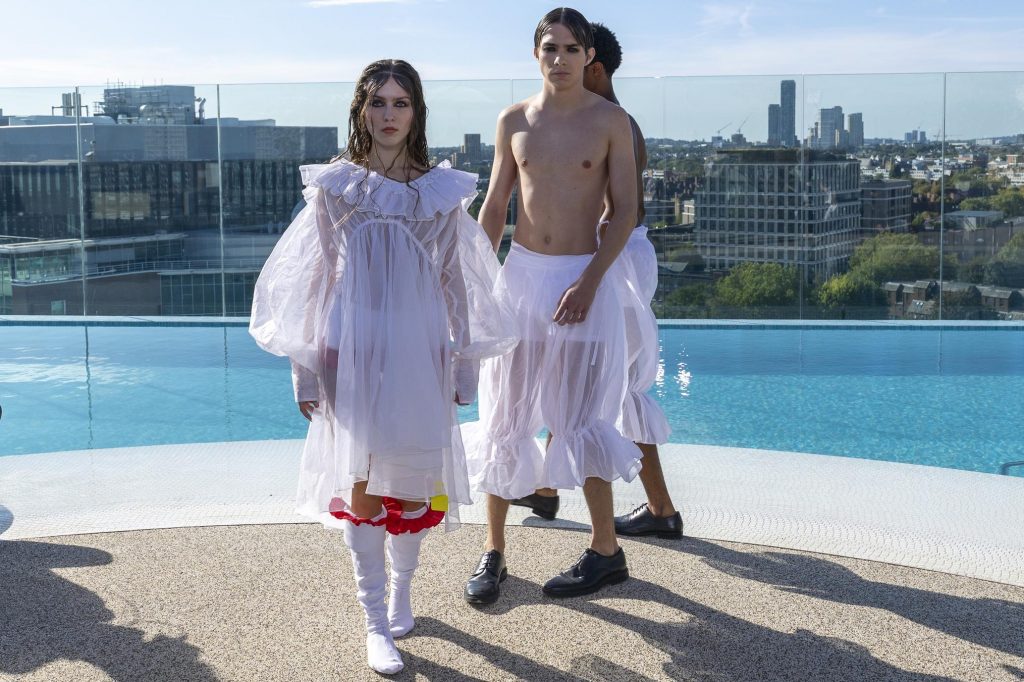Hosting an open-air fashion show is not for the faint-hearted. But the JCA London Fashion Academy is writing its own rules.
Founded by legendary designer Professor Jimmy Choo OBE, the JCA opened its doors in Mayfair in September 2021. Since then, it has quickly made its mark on the global fashion education system by offering bespoke experiences and industry opportunities to students.
And, as luck would have it, the sun was shining for the graduates of the academy’s MA Fashion Entrepreneurship in Design and Brand Innovation who presented their collections on the Westmount Rooftop Terrace in White City during London Fashion Week 2025. 5 new brands took to the runway in an all-woman line-up: 3113 from Elle Curzon, Rethreaded fronted by Grace Emerson, A-Bare-C from Sophie Hollands, Lopuszansky by Jasmyn Lopuszansky, and Trixa helmed by Patricia Reis.
Here are the new names to watch from the JCA London Fashion Academy.
3113
Strikingly editorial, Elle Curzon’s gender inclusive designs opened the show. Inspired by military uniforms and ceremonial dress, the maximalist collection features upcycled and recycled materials, alongside ephemera found at car boot sales and charity shops. Earlier this month, 3113 took part in Centrestage — Hong Kong’s fashion tradeshow — a partnership with the academy, the British Consulate-General Hong Kong, and the Hong Kong Trade Development Council.
In an industry first, the graduates showcased collections to visiting international buyers and fashion media as well as debuting looks on the runway. At the fair, Curzon explained her magpie aesthetic: “I see myself constantly collecting discarded materials, like deadstock fabrics, metal trinkets from boot sales, and even tin cans. I transform these into designs that blur the line between art, sculpture, and fashion.” Curzon’s gather and repurpose approach sees her work with sliced tin cans, feathers, and cut-up deadstock fabrics to create new materialities and value. The political collection centers on male mental health and inner turmoil, exploring how men can embrace more feminine clothing as well as questioning social divisions.
Rethreaded
Grace Emerson might just have single-handedly started a new trend — agricultural streetwear. The designer behind Rethreaded is inspired by farming and physical mending, using surplus and end-of-roll fabrics to celebrate worn and ripped materials. “A lot of my work is sort of glorifying physical mending and the idea that fabrics that are torn and mended actually add to the value of a garment rather than diminishing it,” she explained.
Emerson has been mentored by Orsola De Castro, the founder of the non-profit organization Fashion Revolution. “Her collection is full of potential solutions when it comes to upcycling and creative answers to an environmental challenge, such as waste. It’s exciting to see her grapple with this huge problem that will only grow as time goes by unless some level of responsibility is taken to introduce new methods to the fashion industry,” De Castro shared before the show.
A-Bare-C
Modularity is the name of the game for JCA graduate Sophie Hollands. Her understated collection is based on the simple philosophy that garments are tools to be worn, stowed, and reassembled over time. Her subtle line-up started life as an experiment in styling, about building and reconfiguring looks. Again, it speaks to sustainability and is grounded in the idea of a minimal wardrobe that is expansive in possibility. Hollands’ ethical approach finds new use for materials such as deadstock sourced from British Mills.
Paris-based fashion journalist Lidia Ageeva, who was at the London Fashion Week show, admires the creative and commercial double-pronged approach that is the Academy’s signature. Ageeva feels that Hollands’ approach is rooted in what people really need if they live in a big city: “Each product is engineered for multiple outcomes within a single design, ensuring durability, adaptability, and creative expression without excess.”
Lopuszansky
Jasmyn Lopuszansky’s collection marks her out as a formidable advocate for inclusivity. She designs with the visually impaired in mind. Her journey was sparked by lived experience; she has a family member with age-related macular degeneration. Following months of first-hand research, including interactive focus groups with members of the blind and VI community, the results are a stylish collection that has accessibility at its core.
The visually impaired activist Lucy Edwards, who mentored Lopuszansky during her MA, helped to inform the design process. Edwards thinks that such representation is crucial, especially as currently few, if any designers cater to this overlooked demographic. Lopuszansky uses codes to audio-describe garments and inclusive models and in a refreshing move—an industry first—the graduate described each look as it came down the LFW runway. “When you don’t see yourself represented as a young disabled person who wants to have a career in the beauty industry, you feel so shut out. That’s why what Jasmyn is doing is so important,” said Edwards.
Trixa
Trixa is an expression of empowerment. As founder Patricia Reis explained, it’s for women who want to break the mold and feel sensual. “I played with the idea that a lot of women I know wear more men’s blazers due to their oversized fit and functionality,” she stated. Reis ran with the concept and embarked on an investigation into corporate wear for women.
“I develop my designs by working on the mannequin, playing and juxtaposing men’s suits and women’s lingerie,” she explained after the show. This is how the Garter Trouser with its peekaboo lace garter became the starting point of the collection.
Trixa’s technically tailored garments are crafted from leftover fabrics or materials acquired at carboot sales. What results is a flattering second-skin fit that puts comfort and functionality at its core. Each garment features roomy pockets and signature features such as hook and eye tape closures.

